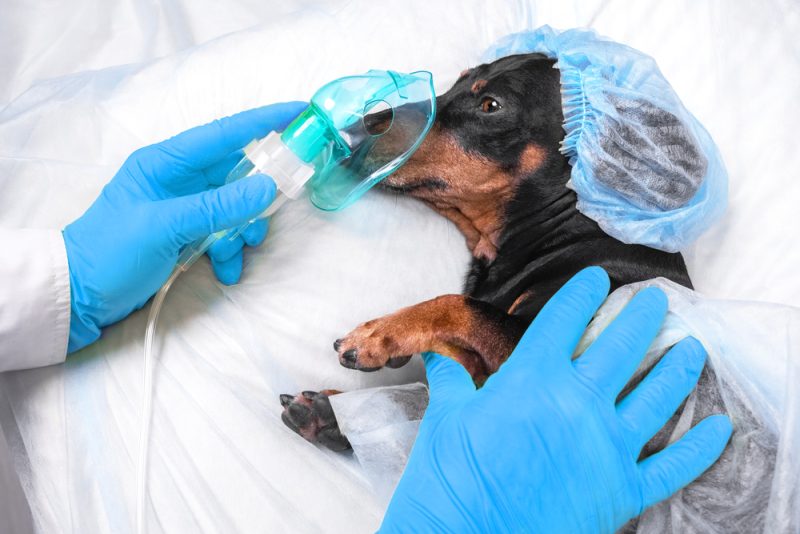Many pet owners are reluctant to pursue anesthetic procedures, because they fear that their sleeping pet may never wake up. At Aloha Veterinary Hospital, we want to assure you that we take every possible precaution and follow the highest standards to ensure your pet’s anesthesia runs smoothly and safely. To put your mind at ease, our experienced team is sharing how our modern anesthetic protocols keep your pet safe.
Why is anesthesia necessary for pets?
We cannot perform surgery or certain procedures without preventing your pet from feeling pain and moving during their procedure. We can accomplish these tasks safely using anesthesia, which is defined as a state of controlled unconsciousness. Sedation or local anesthesia are appropriate for minor procedures, such as imaging tests or wound repair, but anesthesia is the only option for major surgery or dental work. When performed properly, general anesthesia is extremely safe—less than 0.1% of healthy pets die unexpectedly during a procedure.
What happens prior to pet anesthesia?
When they recommend an anesthetic procedure, our veterinarians perform a physical examination at the time, and another exam on the day of the procedure. The examinations, combined with blood tests, help determine your pet’s overall health. If we find something concerning, we can postpone anesthesia to treat their underlying health problem, or adjust drug protocols to meet your pet’s needs. If your pet has evidence of a heart condition, we will refer you to a cardiologist to determine whether they can safely undergo anesthesia.
On the day of anesthesia, we assign a credentialed veterinary technician to be responsible for monitoring your pet’s vital signs and ensuring your pet’s comfort throughout the day. Our veterinary team will administer the chosen injectable sedative medication to relax your pet prior to placing an intravenous (IV) catheter, and will pre-calculate emergency drug doses, so they are readily available should they become necessary. We also provide your pet with anti-nausea medication to ensure they feel well enough to eat when they go home and to reduce potential vomiting. We may also administer an injectable antibiotic for certain procedures, but this is not standard for all pets, because unnecessary antibiotics can promote antibiotic resistance.
What happens during pet anesthesia?
Our team will administer an injectable medication through your pet’s IV catheter to produce short-acting unconsciousness (i.e., anesthetic induction). We never induce your pet using a mask or sedation chamber, which are stressful and unsafe. Shortly after induction, we place a breathing tube in your pet’s trachea to protect their airway from collapse and to seal out fluids that may rise from the stomach. We then attach a multiparameter system to continuously monitor heart rate, heart rhythm, blood pressure, blood oxygen saturation, temperature, and carbon dioxide levels, and administer the anesthetic of oxygen and gas combined through the breathing tube. We use isoflurane, which is one of the safest gas anesthetics, to keep your pet asleep after the induction drug wears off, and to allow us to adjust the concentration as needed.
To maintain blood pressure and ensure proper oxygen circulation to all your pet’s vital organs, we administer IV fluids throughout anesthesia, and may add a substance called hetastarch or give emergency drugs if blood pressure drops too low. To keep body temperature stable, we use warming devices that circulate hot water or forced warm air. Our veterinary team promptly addresses any changes to your pet’s vitals.
What happens after pet anesthesia?
After your pet’s procedure, we turn off the gas and provide pure oxygen to flush the anesthetic from their system. The breathing tube stays in place while your technician continues to monitor vitals as your pet wakes up. Once your pet can swallow on their own, we remove the breathing tube, and return them to their kennel wrapped in warm, comfortable blankets. We continue to check on your pet periodically to ensure their smooth recovery. When you pick up your pet, we’ll provide detailed care instructions and all necessary medications.
What about pain control?

Multimodal pain control (i.e., using multiple drugs together to control pain in different ways) is the most effective way to ensure your pet’s comfort and improve recovery time. We provide pain control with anti-inflammatory and analgesic or opioid medications, combined with local anesthetic nerve blocks. We also send your pet home with pain medications if we expect post-operative pain. Many patients also benefit from scheduling post-op therapeutic laser treatments with us to help decrease inflammation and assist with healing.
With modern pet anesthesia techniques, you no longer have to fear your pet’s surgery or dental procedure. The Aloha Veterinary Hospital team adheres to every possible safety precaution, so you can rest assured your pet is in good hands. Call us to schedule your pet’s pre-surgical consultation or elective procedure, and we will ensure they receive the care they need.







Leave A Comment